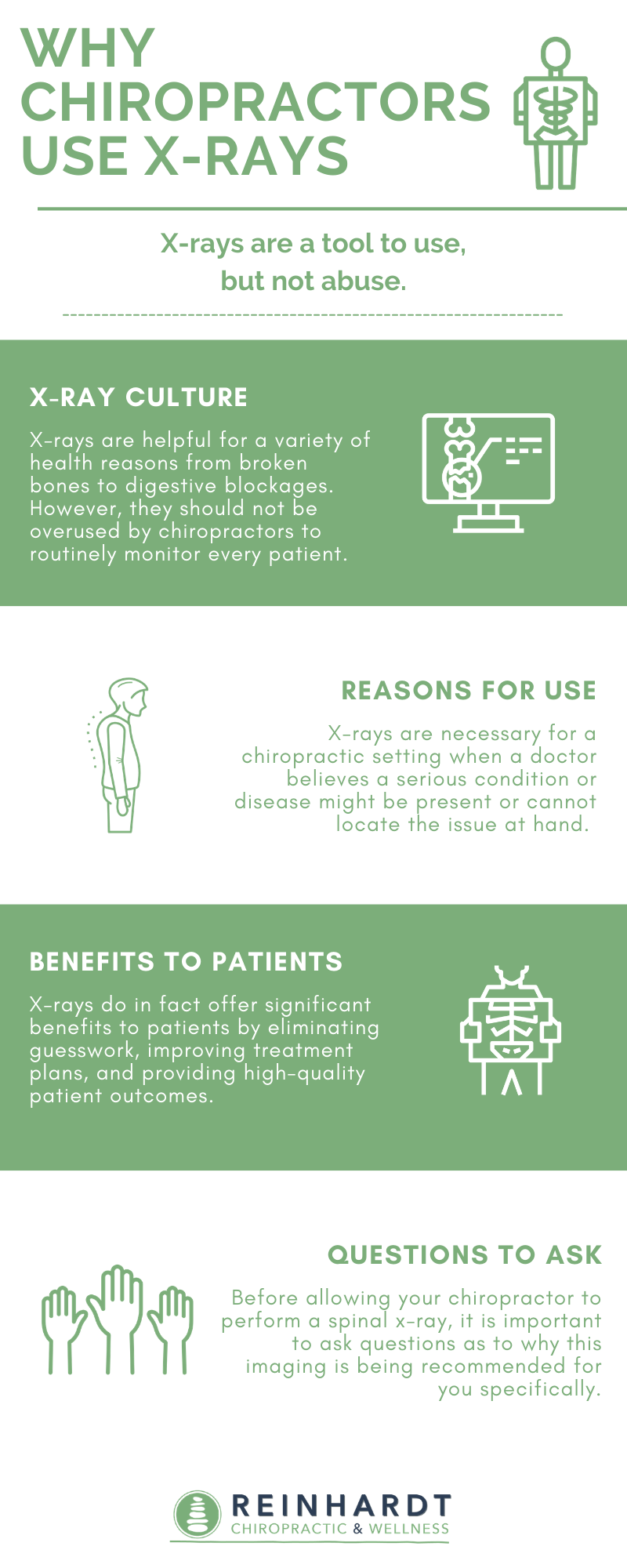When you think about x-rays, you probably think about broken bones. However, the medical use and purpose of x-rays stretch beyond the ability to just identify injuries. Today, x-rays are used by a variety of medical professionals to investigate a wide range of potential issues, such as:
- Bone dislocations and loss
- Infections
- Calcifications
- Arthritis
- Tumors
- Digestive issues
- Heart issues
Due to the nature of chiropractic care, and the lack of inward visibility surrounding a patient’s bone and joint structure, x-rays have become a popular choice for chiropractors to better identify skeletal system issues. In doing so, chiropractors can better diagnose and treat patients moving forward. Some common issues that can be confirmed with the use of x-rays include:
- Spondyloarthritis
- Kyphosis
- Scoliosis
- Minor/major spinal trauma
- Shoulder and Pelvic Malalignment
- Forward Head Posture
- Prior Spinal Fractures
- Degenerative Joint/Disc Disease

Are X-rays Safe?
X-rays are a form of electromagnetic radiation which pass through solid objects, including the body. X-rays penetrate different objects based on their density. As the x-rays pass through the body, images appear in shades of black and white — with more dense objects appearing light-colored and less dense objects (like tissue) showing up grey or black.
However, due to the use of radiation, x-rays can present a health threat to individuals if too many x-ray scans are performed. This negative effect has caused some controversy within the chiropractic community as some chiropractors recommend x-ray scans for all new patients, as well as routine x-rays for current patients in an effort to monitor progress and treatment outcomes. Yet, current evidence only supports the use of spinal x-rays in the diagnosis of trauma, progressive spinal structural deformities, or suspected misalignment concerns.
Here at Reinhardt Chiropractic, we only recommend x-rays to individuals who Dr. Reinhardt believes would medically benefit from the imaging. This is because in some cases, the potential benefits do not outweigh the associated costs. Therefore, the use of x-rays should not be taken lightly and used under a chiropractor’s best judgment.
When visiting a chiropractor for treatment, and they recommend x-ray imaging, some questions you may consider asking include:
- For what specific reason(s) do I need an x-ray?
- If I’m not experiencing pain, how will x-ray imaging be of real benefit to me?
- What other methods or diagnostics are available?
The Benefits to Chiropractic X-ray Imaging
While the vast majority of chiropractic treatment can be done effectively and safely without the need for imaging, sometimes x-rays are a necessary treatment tool. Most chiropractors are able to quickly identify issues, misalignments, and pain sources through physical examination. In the cases that this cannot be done, chiropractors may turn to the use of x-rays to pinpoint the exact root of the problem or gain a full picture understanding of a serious spinal health concern.
Benefits include:
- Elimination of diagnostic guesswork
- Improved treatment plans
- High-quality patient outcomes
Through this process, chiropractors like Dr. Reinhardt can then assess the scans and determine what the exact problem is — and develop the best course of treatment. This is important as some serious spinal injuries or conditions might call for a different type of care or mitigation. At times, surgery or other medical care may be more appropriate compared to spinal manipulation.
X-rays serve as a valuable tool to chiropractors, acting in place of their eyes when physical exams cannot accurately diagnose a problem. The use of x-rays should not be done haphazardly. With that being said, patients should have confidence in their doctor when an x-ray is recommended, as it could help isolate key factors in diagnosing their condition or health status.
Recent Post
From Foggy to Focused: How Alignments Can Boost Brain Function
May 7, 2025
From Foggy to Focused: How Alignments Can Boost Brain Function Many people experience brain fog—slow thinking, forgetfulness, and difficulty concentrating—but don’t always know how to fix it. Often blamed on poor sleep or high stress, brain fog can also stem from a lesser-known source: spinal alignment. Yes, the health of the spine plays a crucial
Read More…
The Benefits of Combining Massage Therapy and Chiropractic Care
April 2, 2025
When people think of chiropractic care, they often picture adjustments and spinal alignment. While these are core components of what we do, the benefits of chiropractic care can be amplified when combined with massage therapy. The synergy between these two treatments enhances healing, improves mobility, and supports long-term wellness. Let’s explore how massage therapy
Read More…

